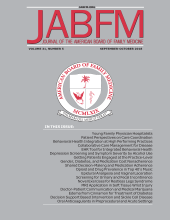Abstract
A race and gender salary gap has been well-documented throughout the U.S. economy, but little described in primary care. Using self-reported data on the most widely distributed primary care physician specialty, we reveal lower incomes and hourly wages among Black/African American and female family physicians. The clear gradient in family physician compensation by race and gender demands further study and action to better understand and address the underlying sources of these differences.
The disparities in pay according to both race and gender have been well documented throughout the US economy. The 2019 US census revealed women to make 82 cents per dollar that men make, and women of color only 65 cents on the dollar.1 The median Black household earned 61 cents and the median Hispanic household 74 cents for every dollar earned in the median white household.2 While these gaps have narrowed slightly over the past decade, their persistence suggests an undervaluing of female and racial/ethnic minority employees generally, and especially women of color. Although physicians are among high wage earners overall, the race and gender pay gap persists in the physician workforce.3 Disparities in pay may contribute to increased rates of moral injury among women physicians,4 although the data are less clear about a similar effect in physicians underrepresented in medicine (URM).5 Little is known about the overall size of race and gender pay disparities of family physicians (FPs). This study investigates the disparity at this intersection.
We used 2019 and 2020 data collected on the American Board of Family Medicine (ABFM) National Graduate Survey, including self-reported clinical income and work hour data.6 The survey was administered to all ABFM diplomates 3 years after residency completion and had a 61.2% response rate. We analyzed participant free text responses to 2 items on the survey, “What is your most recent pretax annual clinical income?” and “Please estimate your typical workload (hours per week),” and included only respondents providing direct patient care who have complete race, income, and hours data. To account for hours worked, the total number of weekly hours reported was multiplied by 52 to obtain an estimate of annual hours worked. Hourly pay was calculated by dividing reported income by annual hours worked and results were stratified by gender and race/ethnicity. The American Academy of Family Physicians Institutional Review Board approved this study.
The trends in reported income by race and gender (Figure 1) were largely consistent with overall national data. Male respondents reported higher annual incomes than female respondents in every racial/ethnic group. On average, White female respondents reported the lowest number of hours worked per week (50.5) while Black male respondents reported the highest (62.7). Overall, male respondents reported an average of 56.5 hours of work per week, compared with 53.1 hour reported by female respondents. Male FPs had higher hourly wages than female FPs in all racial/ethnic groups except for Black/African American males, who reported working more hours than any other group. Furthermore, respondents identifying as White reported higher incomes than Asian and African-American FPs within each gender group.
Average annual income & hourly compensation of board certified family physicians by race/ethnicity and gender.
These findings unveil substantial overall income and hourly compensation disparities according to race and gender among newly graduated family physicians providing direct patient care. African American men and women FPs are disproportionately impacted compared with the national average. Female FPs are generally making 11 to 17% less on the dollar than their male counterparts. African American male physicians reported working more hours than any other group, suggesting that they are working more hours for less pay than other male FPs. These disparities may result from a number of factors including the location and practice settings where URM and women physicians work, the populations they serve and payer type, billing practices, patient volume and time spent per visit, or negotiated initial salary offers.7,8 Women physicians are more likely to use parental and family leave and to negotiate modified schedules,9 an observed phenomenon which could result in decreased annual income among this cohort, but which should be accounted for by our hourly pay calculations. While this study may be limited by the fact that the responses are self-reported and include a wide variety of compensation schema, the data should still compel further exploration. Finally, the data suggest the need to explore the contributions of more insidious factors like race and gender discrimination in contract negotiations or salary offers.10 Further research is needed to identify and address the underlying causes for these observations.
Notes
This article was externally peer reviewed.
To see this article online, please go to: http://jabfm.org/content/35/4/859.full.
Conflict of interest: AB, MT, ZM, TW, and AE are employed by the ABFM. RHO is employed by the AAFP. AA is an ABFM Board Member.
Funding: None.
To see this article online, please go to: http://jabfm.org/content/35/4/000.full.
See Related Commentary on Page 870.
- Received for publication November 23, 2021.
- Revision received February 4, 2022.
- Accepted for publication February 9, 2022.








